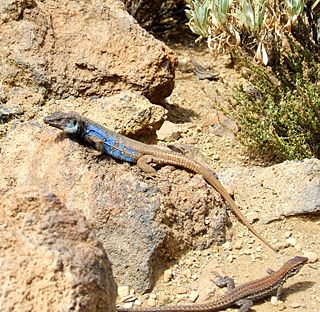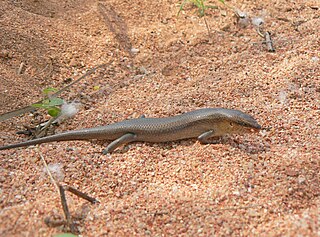Hungarian notation is an identifier naming convention in computer programming in which the name of a variable or function indicates its intention or kind, or in some dialects, its type. The original Hungarian notation uses only intention or kind in its naming convention and is sometimes called Apps Hungarian as it became popular in the Microsoft Apps division in the development of Microsoft Office applications. When the Microsoft Windows division adopted the naming convention, they based it on the actual data type, and this convention became widely spread through the Windows API; this is sometimes called Systems Hungarian notation.

The genus Gallotia are the lacertids of the Canary Islands. This genus consists of a group that has been evolving there ever since the first islands emerged from the sea over 20 million years ago. The endemic species and subspecies of this group have a number of characteristics that make them quite special within their family (Lacertidae); their only close relatives are the sandrunner lizards (Psammodromus) of the western Mediterranean region. Gallotia are characteristic for eating significant quantities of plants, and several lineages are often presented as classic examples for insular gigantism. However, a find of an even larger Gallotia species from the early Miocene of mainland Europe casts doubt on this assumption. Instead the ancestor of all modern Gallotia species of the Canary islands was probably already very large but carnivorous.

Charles Simonyi is a Hungarian-American software architect.

Sándor Simonyi-Semadam was a Hungarian politician who served as prime minister for a few months in 1920. He signed the Treaty of Trianon after World War I on 4 June 1920. By this treaty, Hungary lost a considerable part of its territory. Simonyi was a member of the Hungarian-Nippon Society, a society for creating cultural links between Japan and Hungary. On 4 June 1946, Simonyi-Semadam died at his home in Budapest.
In computer programming, Intentional Programming is a programming paradigm developed by Charles Simonyi that encodes in software source code the precise intention which programmers have in mind when conceiving their work. By using the appropriate level of abstraction at which the programmer is thinking, creating and maintaining computer programs become easier. By separating the concerns for intentions and how they are being operated upon, the software becomes more modular and allows for more reusable software code.
In mathematical analysis, nullclines, sometimes called zero-growth isoclines, are encountered in a system of ordinary differential equations

András Simonyi is a former Hungarian ambassador, transportation economist, author. He is an independent consultant living in the U.S. He is a senior fellow at the Global Energy Center Atlantic Council of the United States. He is also associated with the George Washington University, Washington D.C. From 2012 to 2018 he was the managing director of the Center for Transatlantic Relations at the Paul Nitze School of Advanced International Studies at Johns Hopkins University in Washington DC. He was the Hungarian ambassador to the United States between 2002 and 2007. He was also Hungary's first ambassador to the North Atlantic Treaty Organization. His professional focus today is energy security, the role of the private sector in energy transition.

The Soyuz TMA-14 was a Soyuz flight to the International Space Station, which launched on 26 March 2009. It transported two members of the Expedition 19 crew as well as spaceflight participant Charles Simonyi on his second self-funded flight to the space station. TMA-14 was the 101st crewed flight of a Soyuz spacecraft, including launch failures; however, it was the 100th to launch and land crewed, as Soyuz 34 was launched uncrewed to replace Soyuz 32, which landed empty.

Hakaria is a genus of skink, a lizard in the family Scincidae. The genus contains one species, Hakaria simonyi, which is endemic to Socotra.

András "André" Simonyi was a footballer who played for Lille OSC, FC Sochaux, Red Star 93, Rennes, Angers SCO, Stade Français and CO Roubaix-Tourcoing. Born in Hungary, he represented the France national team.
The Simonyi Professorship for the Public Understanding of Science is a chair at the University of Oxford. The chair was established in 1995 for the ethologist Richard Dawkins by an endowment from Charles Simonyi. The aim of the Professorship is 'to communicate science to the public without, in doing so, losing those elements of scholarship which constitute the essence of true understanding'. It is a position that had been endowed by Charles Simonyi with the express intention that the holder "be expected to make important contributions to the public understanding of some scientific field", and that its first holder should be Richard Dawkins.

Baron Lajos Simonyi de Barbács et Vitézvár was a Hungarian politician, who served as Minister of Agriculture, Industry and Trade between 1875 and 1876. He studied law in Kassa. From 1847 he was a delegate on the Diet in Pest. He participated in the Hungarian Revolution of 1848, he performed courier service besides Artúr Görgey. As a result, he was imprisoned for a short time. Later he was a supporter of László Teleki. Simonyi retired from politics in 1878.

The Embassy of Hungary in Washington, D.C. is Hungary's diplomatic mission to the United States. It is located at the Brodhead-Bell-Morton Mansion. Consular and administrative offices are still located at 3910 Shoemaker Street, Northwest, Washington, D.C., in the Cleveland Park neighborhood. The 3910 Shoemaker Street location of the Embassy of Hungary in Washington, D.C. still hosts several events, like the EU Open House. Hungary also has consulate offices in Chicago, New York City and Los Angeles.

Sybrinus is a genus of longhorn beetles of the subfamily Lamiinae, containing the following species:
Sybrinus grossepunctipennis is a species of beetle in the family Cerambycidae. It was described by Stephan von Breuning in 1950.
Sybrinus albosignatus is a species of beetle in the family Cerambycidae. It was described by Stephan von Breuning in 1948.
Sybrinus flavescens is a species of beetle in the family Cerambycidae. It was described by Stephan von Breuning in 1948.

Sybrinus commixtus is a species of beetle in the family Cerambycidae. It was described by Gahan in 1900.
Sybrinus x-ornatus is a species of beetle in the family Cerambycidae. It was described by Téocchi, Jiroux and Sudre in 2007. It is known from Yemen.

Erzsébet Simonyi was a veterinarian in Hungary and the first woman to gain a veterinary degree in Hungary (1937). She began a private practice in 1940 and from 1948 to 1952 worked at Phylaxia Vaccine Production Company. In 1952, she became the first woman to head a scientific institution in Hungary, when she was asked to found the Veterinary Vaccine Control Institute for the Department of Agriculture. The purpose of the institute was to develop immunization processes and controls for developing and administering vaccines and Simonyi led it until 1971. In 2012, the Institute became the Directorate of Veterinary Products of the National Food Chain Safety Office.










